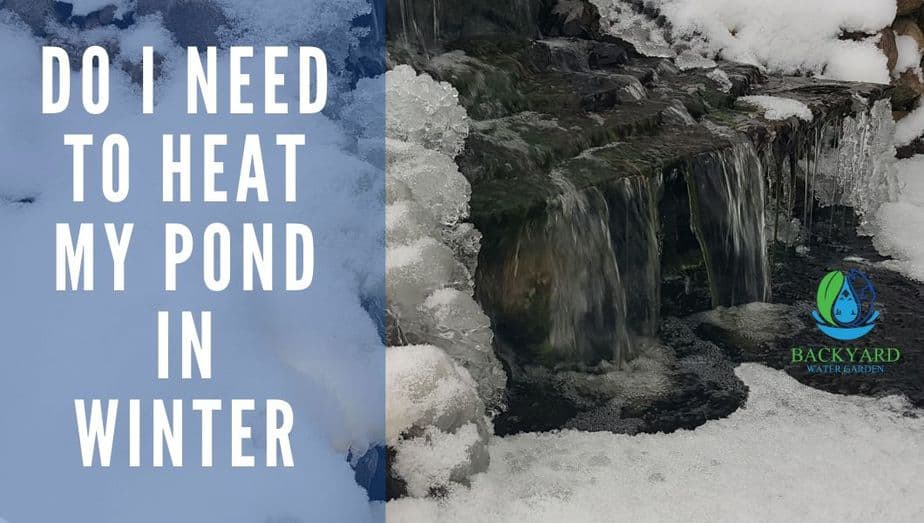
Do I need to heat my pond in winter? A common question I get asked on a regular basis. Especially where I’m located, in the North East just outside of Buffalo New York. Our reputation for snow is far and wide.
What most consider a ‘pond heater’ doesn’t exactly heat the water in the sense that you would think it does. The pond heater merely keeps a hole in the ice for poisonous gasses to escape, keeping your fish alive during the cold winter months.
Fish are cold blooded. Cold blooded creatures can survive in much harsher climates than mammals can. Fish react to the temperature differently than we do. When the temperature drops their body and metabolism slows down. This is what allows them to survive the cold water temperatures through the winter season.
Pond Heating Ideas
The easiest way to keep your fish alive through winter is to place an aerator in the water. Not only does this add free oxygen to the water, it also disrupts the formation of ice that could cap off your pond and suffocate your fish. Read our article about pond aeration and its benefits for more information.
The next strategy would be to use a pond heater. Now as mentioned before, it does not heat the entire body of water. It only melts a small portion of the ponds surface keeping it open for poisonous gasses to escape.
The best thing to do is to use these two together. Anchor the pond heater directly over the aerator. This way if it gets incredible cold the agitation from the aerator will keep the pond heater in contact with the water's surface.
Should I Cover My Pond In Winter
If your pond does not have any fish in it and you wish to keep any and all debris out of it then go ahead and cover it. However if you have any fish at all, do not cover it. Use a pond net to keep debris out. Keep in mind that you do not need to completely shut down your pond during the winter.
Submersible Pond Heaters
One option you have at your disposal is to use a submersible heater such as the ones used for livestock. Although we don’t recommend this as our first choice it will keep the water from freezing solid.
A client of mine uses one of these in his shallow pond. He has kept goldfish through many cold winters using this technique. His pond is only 18 inches deep at the deepest point. Leaving his waterfall running all winter helps circulate the water adding oxygen.
A word of caution if you plan on using a heater like this. It will melt your rubber liner if it comes in contact with it. This will lead to a whole new range of problems. Repairing a liner in the dead of winter is not fun for anyone.
How Do Pond Fish Survive In Winter
Fish are cold blooded. This means that their metabolism slows down in reaction to temperature change. During the winter your fish go into a dormant state. Their digestion slows down and they tend to settle in groups in the deeper part of your pond. Some may even burrow down in sediment similar to frogs during this time.
According to https://oceanservice.noaa.gov/facts/fish-freeze.html during the frigid winter days the warmer water is actually at the bottom of your pond. If the surface of your pond freezes over, this will actually insulate the warmer water towards the bottom.
If you use an aerator during the winter, be sure to place it no deeper than half the depth of your pond. This prevents the warmer water below from being disturbed. The purpose of the aerator is to keep a portion of the ice from freezing over allowing for ventilation.
Ventilation
As long as there is a hole in the ice of a frozen over pond for the built up poisonous gasses to escape, the fish will survive.
Getting Through Winter
You can still enjoy your waterfall through the harsh winter. If you planned the placement of your water feature correctly it should be visible from inside your home. There is nothing more majestic than looking out at a waterfall in a crisp winter morning.

The right lighting will add to the enjoyment of your pond through the winter months. With the nights getting longer, having a good flood light or spotlight on your water feature is essential.
Key Takeaways
- Use proper aeration throughout the winter
- Place aerator in the upper to middle layer of your pond
- Keep a hole in the ice for ventilation
- Do not disturb the bottom layer of the pond
Conclusion
Winter doesn’t have to mean the end of the enjoyment you get from your water feature. Keep the key points in mind and you will make it through the winter. Spring is just around the corner. Until next time enjoy your backyard water garden.
~Jeff





